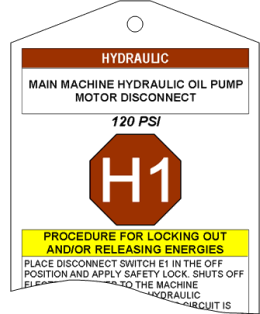Home » Lockout Resources » Energy Source Reference » Hydraulic Energy Sources
Hydraulic Energy Sources

Definition of Hydraulic Energy
Hydraulic energy pertains to the power related to pressurized fluid, typically hydraulic fluid, used to accomplish machine motion. The pressure can be relatively static (such as reservoirs) or in motion though tubing or hoses. A good percentage of industrial equipment subject to OSHA 1910.147 will have at least one hydraulic Energy Source. To do useful work, industrial equipment often converts hydraulic energy into other forms of kinetic or Potential Energy.
Associated Hydraulic Energy Hazards
Per OSHA, there are hundreds of injuries annually due to improper handling of hydraulic energy.
Injuries associated with hydraulic energy generally consist of the following:
- Eye injuries due to released pressure or blown debris.
- Skin abrasions/punctures when exposed to high pressure fluid stream.
- Unexpected machine motion due to hydraulic pressure acting on machine components. Such actions could result in lacerations, pinching, crushing, or amputation.
Proper Lockout/Tagout can virtually eliminate the risk involved with hydraulic energy.
Means of Hydraulic Energy Isolation
Hydraulic energy must be controlled via a mechanical energy isolating device that physically prevents the transmission or release of energy. Some systems may have accumulators or intensifiers that require distinct practices to release pressure. Further details about handling hydraulic accumulators and intensifiers is available at the Stored Hydraulic Energy page.
Verifying Absence of Hydraulic Energy
Verifying the absence of hydraulic energy after performing Lockout/Tagout can be done by attempting to operate the associated components and by observing the associated gages to ensure they indicate 0 (zero) pressure.
Typical Hydraulic Energy Isolation Devices
Hydraulic energy isolation devices may vary in design and configuration. Typical examples include:
- Gate Valves.
- Ball Valves.
- Butterfly Valves
- Flanges that allow a blank to be inserted.
Typical Hydraulic Energy Lockout Devices
Hydraulic energy Lockout devices use positive means such as a lock and key to keep the associated energy isolation device in the safe position and prevent equipment energization. Typical hydraulic energy lockout devices are outlined in the Valve and Pneumatic page.
Lockout Services | Turnkey Programs | Lockout Procedures | Single-Source Procedures | Basic Procedures | Standard Procedures | Advanced Procedures | Custom Procedures | Energy Control Tags | Alternative Protective Measures | Minor Servicing Exception | Online Services | Lockout Audits | Corporate Standards | Lockout Training | Reference Guides | Services RFQ | DEenergizer | Lockout Devices | Electrical | Valve and Pneumatic | Accessories | Group Lockout/Tagout | Devices Index | Devices RFQ | Lockout Resources | OSHA Documentation | NIOSH Documentation | White Papers and Articles | Lockout/Tagout FAQ | Lockout/Tagout News | Lockout/Tagout Signs | Energy Source Reference | Training Material | Library | Glossary | Sitemap | About | Contact Information | Careers | Privacy Policy | Terms of Use | Legal Notice

